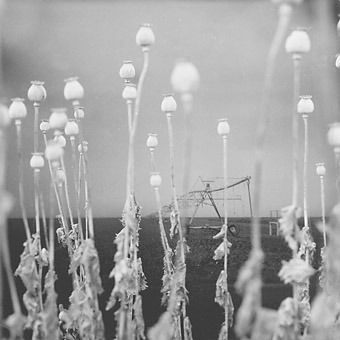Double vision at Stills
Virginia Baxter, Brenda L Croft, Christine Cornish, Rebecca Shannahan

Untitled, 2001 from The Acclimatisation Project, iris prints on rag paper
courtesy the artist
Untitled, 2001 from The Acclimatisation Project, iris prints on rag paper
You really need to look twice at the works in Stills latest show. It takes a lingering look to make out within the glossy religious icons of Brenda L Croft’s cibachromes the blurry black and white portraits of Aboriginal people. At a distance, you could disappear into Christine Cornish’s gelatin silver photographs of “real and simulated spaces, random objects and images suggesting ephemeral cultural phenomena.” They look like drawings until you move in on them to see they are both.
Without knowing the history of Rebecca Shannahan’s images, my eyes had already begun to reconstitute plausible places from the improbable ones she had set up in her studio—combining disparate elements with words like “haunting” and “exotic” vying for attachment. Reading her notes on the Acclimatisation Project made the second viewing a whole new experience.
“The photographs depict plants set against landscapes. The plants’ histories of circulation and exchange make them useful metaphors for mobile, fluid cultures: the Andean potato was the direct cause of Irish migration to the United States; speculation on the Chinese tulip brought the Dutch economy to near collapse; opium from Turkish poppies grown in India gave the British their desired trade with China. The landscape backdrops refer to landscape photography’s ‘surveyor peg’ function in colonised countries—images which assert possession, acquisition, the right to belong. In this way, ‘foreign’ species and local views are joined within a single pictorial space.”
The grain in the images I thought I’d seen before. It’s a familiar of contemporary photographs. But perhaps no other photographer has gone to such lengths to achieve it. Each negative used in the series was sent to the country of origin of the plant it depicts. There, an assistant placed the negative near where they lived, to weather, or acclimatise, outside. When they felt their negative had stayed long enough, they sent it back to Australia to be printed. This process allowed each negative to experience a place as well as depict it and degraded the photographic emulsion which normally supplies a faithful representation of reality.”
–
Stills Gallery, Brenda L Croft, Christine Cornish, Rebecca Shannahan; March 14-April 14.
RealTime issue #42 April-May 2001 pg. 36






